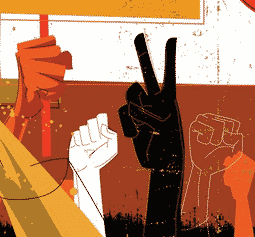Radical Seattle:
The General Strike of 1919
by Cal Winslow
$26.00, 308 pages
Reviewed by Alex Miller
For five days in the winter of 1919, Seattle’s Central Labor Council orchestrated a strike that brought a city of 315,000 to a standstill, and, in the process, brie y realized the revolutionary potential of a uni ed working class. However, the Seattle General Strike was more than an exercise of labor’s might; it was a radical experiment in nonviolent self-government that explored what a society organized by and for the people might look like. Evoking memories of the Russian Revolution, the “Seattle Commune,” as it came to be known in the reactionary press of the time, remains a significant, if misunderstood, moment in American labor history. Was it, as Robert Friedheim wrote in 1964, an unmitigated failure that heralded a national turn toward repressive labor policy and sentiment, or did its fleeting accomplishments provide valuable lessons in the possibilities of collectivism that might inform how we approach the myriad crises we face today? Cal Winslow’s Radical Seattle arrives at a propitious moment. Not only does Winslow’s study commemorate the centennial of the General Strike; it also contextualizes it within a history of oppression and resistance that persists to this day. In fact, Winslow frames his analysis by challenging his reader to consider what of the revolutionary spirit of the era endures. Re-approaching this history in a year that has witnessed a global pandemic, national calls for racial and economic justice, and the continuing rise of both nationalism and authoritarianism, the General Strike of 1919 is both instructive and uncannily familiar — a valuable contribution to our understanding of the role of the Seattle General Strike in shaping and reflecting the politics of its era.
Unlike Friedheim’s The Seattle General Strike (2018 [1964]), which focuses primarily on the immediate context of the strike and its aftermath, Winslow’s history traces a “decade-long making of a collective” that positioned Seattle on the avant-garde of radical labor activism in the postwar moment. Radical Seattle attends to the sea change of thought and action surrounding industrial organizing that occurred as the IWW established itself as a central player in shaping the labor politics of the region. Moreover, Winslow contextualizes these local developments within a larger historical narrative that documents the role international events played in shaping the revolutionary spirit of the era.
Winslow’s opening chapters provide a succinct overview of the meteoric growth of the region’s industries, which motivated a corresponding explosion of migrating settlers seeking economic opportunity in the nation’s peripheral territories. As is always the case, with expansion came new modes of exploitation, particularly in Washington’s extractive industries, where a largely immigrant workforce fueled the nascent economy. Though forced to submit to the hardships required to establish themselves in the region, these workers were also heirs to a generation of radicals who, decades earlier, exercised their collective might in demonstrations of solidarity that brought many of the nation’s industries to a standstill. According to Winslow, this legacy of activism provided the seeds of dissent that would eventually blossom during Seattle’s General Strike.
Radical Seattle identifies the IWW as a catalyst for the germination of a class consciousness that encouraged individual laborers to recognize a kinship in their struggle and respond collectively. Winslow’s history ties the burgeoning radicalism of the region to the IWW’s growing influence within the labor movement, establishing a chronology that connects the free speech rights in Spokane to the General Strike and beyond. This history includes the massive demonstrations of solidarity that won an eight-hour workday in the timber fields as well as examples of violent, state-sponsored repression, as witnessed in Winslow’s vivid retelling of the events surrounding the Everett Massacre. Throughout these central chapters, Radical Seattle supplements its narrative with primary documents and personal accounts that survey the spectrum of opinion regarding the IWW’s emergence as a dominant force in the region, demonstrating the efficacy of the Wobblies’ early forays into organizing workers throughout the Pacific Northwest.
If the first half of Radical Seattle outlines the rise of the IWW in Washington, then the second half tells the story of the role both local and global events played in its dissolution. The United States’ entry into World War I had im- mediate economic reverberations that resounded throughout the Northwest. As the demand for timber and ships surged, so too did the rolls of Seattle’s unions, which witnessed a 300% increase from 1916 to 1918. During this period, James Duncan, the secretary of Seattle’s Central Labor Council (CLC), exerted a unifying force upon the city’s 110 recognized unions, striking a precarious accord between the moderation of Samuel Gompers’ American Federation of Labor (AFL) and Seattle’s radical left. Duncanism, as it came to be known, established policy that placated the majority of Seattle’s labor leaders while wartime demands kept production steady. However, as Armistice Day approached, demands for production slowed, and unions were left to fend for themselves against a betrayal coordinated between their employers and the government that would lead directly to the Seattle General Strike.
Winslow’s account of the strike itself rejects Friedheim’s characterization of events of 1919 as “a disaster,” suggesting instead that the Seattle General Strike was a compelling demonstration of labor’s power when properly organized…..
Read the rest by picking up a copy of Science & Society


Comments are closed.